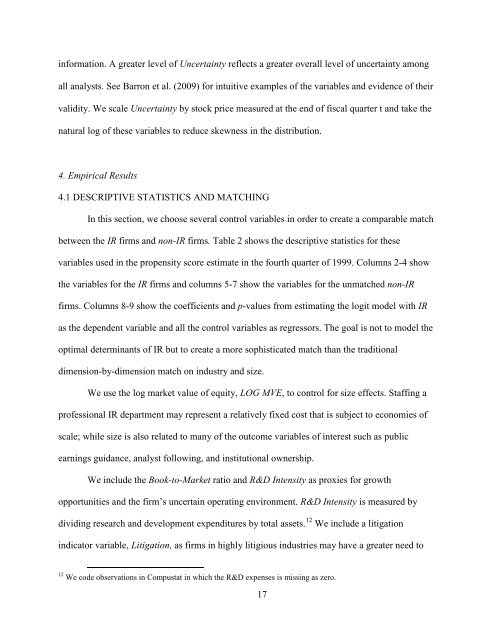Investor Relations and Regulation FD
Investor Relations and Regulation FD
Investor Relations and Regulation FD
You also want an ePaper? Increase the reach of your titles
YUMPU automatically turns print PDFs into web optimized ePapers that Google loves.
information. A greater level of Uncertainty reflects a greater overall level of uncertainty among<br />
all analysts. See Barron et al. (2009) for intuitive examples of the variables <strong>and</strong> evidence of their<br />
validity. We scale Uncertainty by stock price measured at the end of fiscal quarter t <strong>and</strong> take the<br />
natural log of these variables to reduce skewness in the distribution.<br />
4. Empirical Results<br />
4.1 DESCRIPTIVE STATISTICS AND MATCHING<br />
In this section, we choose several control variables in order to create a comparable match<br />
between the IR firms <strong>and</strong> non-IR firms. Table 2 shows the descriptive statistics for these<br />
variables used in the propensity score estimate in the fourth quarter of 1999. Columns 2-4 show<br />
the variables for the IR firms <strong>and</strong> columns 5-7 show the variables for the unmatched non-IR<br />
firms. Columns 8-9 show the coefficients <strong>and</strong> p-values from estimating the logit model with IR<br />
as the dependent variable <strong>and</strong> all the control variables as regressors. The goal is not to model the<br />
optimal determinants of IR but to create a more sophisticated match than the traditional<br />
dimension-by-dimension match on industry <strong>and</strong> size.<br />
We use the log market value of equity, LOG MVE, to control for size effects. Staffing a<br />
professional IR department may represent a relatively fixed cost that is subject to economies of<br />
scale; while size is also related to many of the outcome variables of interest such as public<br />
earnings guidance, analyst following, <strong>and</strong> institutional ownership.<br />
We include the Book-to-Market ratio <strong>and</strong> R&D Intensity as proxies for growth<br />
opportunities <strong>and</strong> the firm’s uncertain operating environment. R&D Intensity is measured by<br />
dividing research <strong>and</strong> development expenditures by total assets. 12 We include a litigation<br />
indicator variable, Litigation, as firms in highly litigious industries may have a greater need to<br />
12 We code observations in Compustat in which the R&D expenses is missing as zero.<br />
17
















